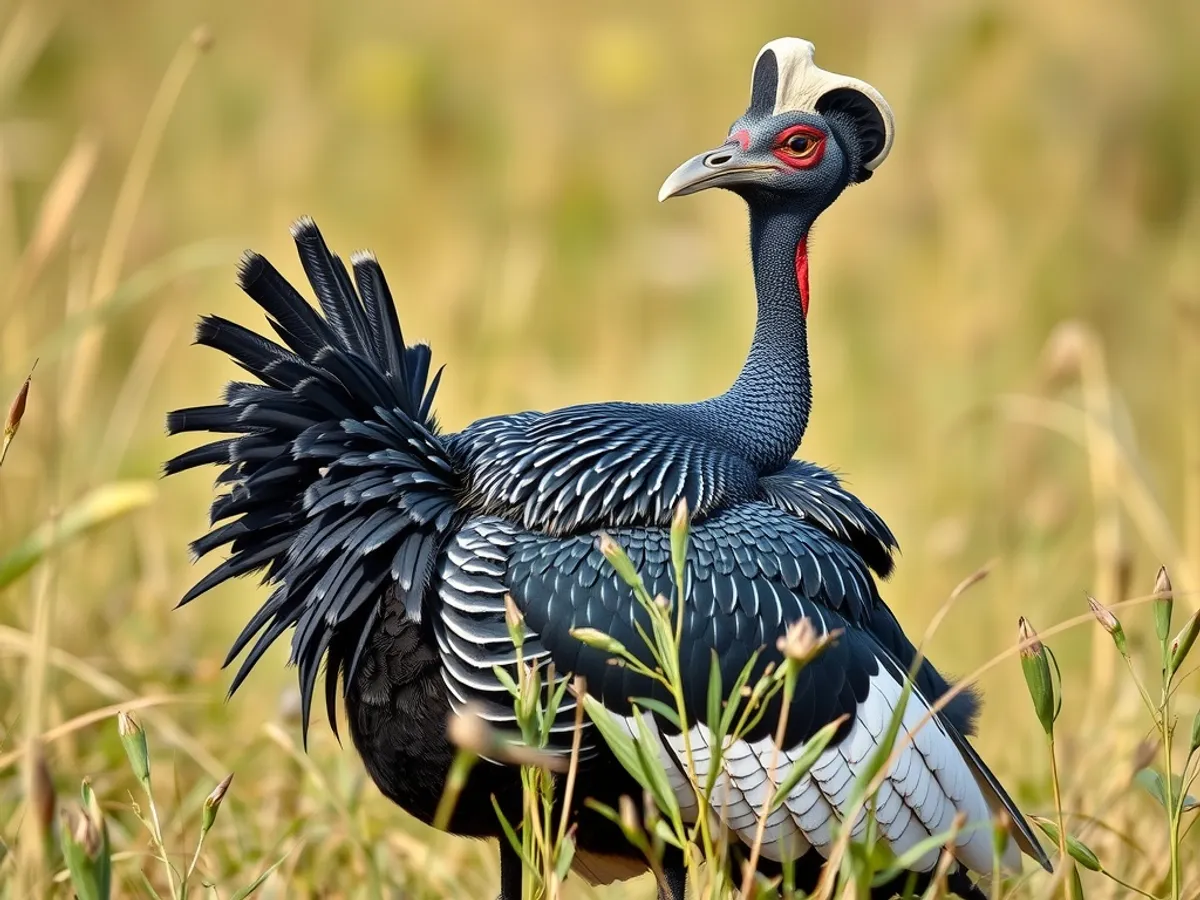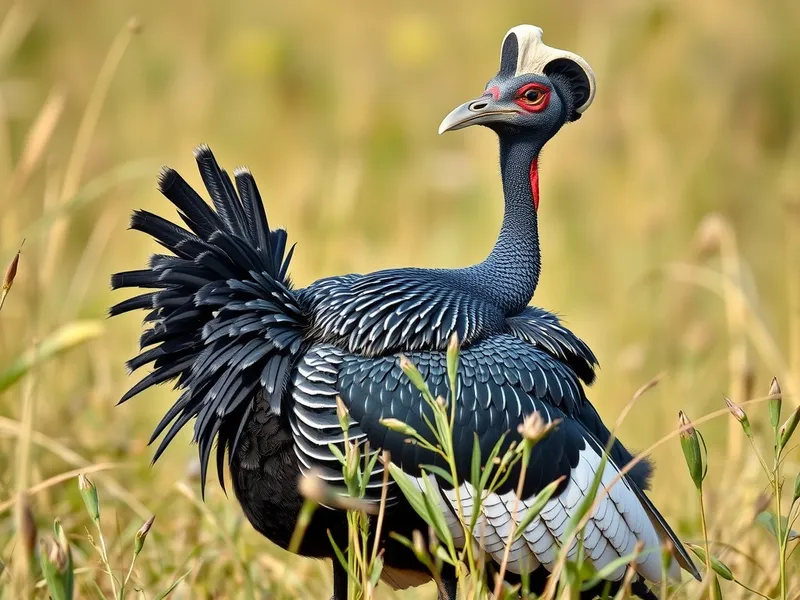
Helmeted Guineafowl
Numida meleagris

Meet the Helmeted Guineafowl
The Helmeted Guineafowl is a large, ground-dwelling bird native to Africa, easily recognized by its distinctive featherless, bony casque or "helmet" atop its head and its spotted, gray-black plumage. These birds are highly social, moving in flocks and producing loud, distinctive calls, especially when alarmed. Helmeted Guineafowl are strong runners and prefer to flee danger on foot rather than fly, though they can fly short distances when necessary. They have been widely domesticated and introduced to other regions, including Europe and the Americas, for their meat, eggs, and pest control abilities.
Classification
Bird
Habitat
Open savannas and grasslands
Diet
Omnivore
Lifespan
10-15 years
Conservation
Least Concern
Weight
1.3-1.6 kg
📖Fascinating Facts
Distinctive Helmet
The Helmeted Guineafowl is named for the prominent, bony casque or "helmet" on its head, which is used for display and species recognition.
Prolific Layers
Females can lay up to 30 eggs in a hidden ground nest, which are incubated for about 26-28 days before hatching.
Fast Runners
Helmeted Guineafowl can run at speeds up to 22 km/h (14 mph) to escape predators, using their strong legs and low body posture.
📋Detailed Description
The Helmeted Guineafowl (Numida meleagris) is a robust, medium-sized terrestrial bird, typically measuring 53–58 cm in length and weighing between 1.3 and 1.6 kg. Its most distinctive feature is the prominent, helmet-like bony casque atop its bare, bluish-gray head, which is further adorned with red or yellow wattles and patches of bright blue skin. The body is covered in dark gray to black plumage, densely speckled with small white spots, providing effective camouflage in dappled grassland environments. The wings are short and rounded, adapted for brief, explosive flight, but the species is primarily a strong runner, relying on speed and agility to evade predators. Helmeted Guineafowl are highly gregarious, forming flocks of up to 25 individuals outside the breeding season, and exhibit complex social hierarchies. Their vocalizations are loud and varied, including alarm calls, contact calls, and territorial displays. They spend much of the day foraging on the ground for seeds, insects, and small vertebrates, using their strong bills to scratch and dig. Roosting occurs communally in trees or elevated structures at night to avoid ground predators. The species is well-adapted to arid and semi-arid habitats, with a broad tolerance for temperature and water scarcity, and is known for its resilience and adaptability, which have facilitated its successful domestication and global introduction.
💡 Did you know?
Despite being ground dwellers, Helmeted Guineafowl roost in trees at night to avoid predators.
🔬Research & Sources
Wikipedia Summary
The helmeted guinea fowl is the best known of the guinea fowl bird family, Numididae, and the only member of the genus Numida. It is native to Africa, mainly south of the Sahara, and has been widely introduced, as a domesticated species, into the West Indies, North America, Colombia, Brazil, Australia and Europe.
Last Modified: 6/2/2025
🎭Behavior & Social Structure
Helmeted Guineafowl are diurnal, with peak activity during early morning and late afternoon. Foraging is a cooperative activity, with individuals maintaining visual and vocal contact while searching for food. Their omnivorous diet includes seeds, tubers, fruits, invertebrates (such as termites, beetles, and ticks), and occasionally small reptiles or amphibians. They are particularly valued for their role in controlling agricultural pests, notably ticks that transmit diseases to livestock. Social interactions are complex, involving dominance hierarchies established through displays, vocalizations, and occasional physical confrontations. During the breeding season, pairs may isolate from the flock, but outside this period, they exhibit strong flock cohesion. Helmeted Guineafowl are vigilant and responsive to threats, emitting loud, repetitive alarm calls and rapidly fleeing on foot. Dust-bathing and sunning are common maintenance behaviors. Roosting is communal, typically in trees, which provides safety from nocturnal predators.
👶Reproduction & Life Cycle
Breeding typically coincides with the onset of the rainy season, when food is most abundant. Helmeted Guineafowl are seasonally monogamous, with pairs forming at the start of the breeding season. Courtship involves vocalizations and displays, such as circling and feather fluffing. Females lay 6–12 cream-colored eggs in a shallow, well-concealed ground scrape, often under dense vegetation. Incubation is performed solely by the female and lasts approximately 26–28 days. Chicks are precocial, leaving the nest within hours of hatching and following the mother, who provides guidance and protection. Both parents may assist in leading the brood, but only the female incubates. Fledging occurs at around 4–5 weeks, but young remain with the family group for several months, gradually integrating into larger flocks.
🛡️Adaptations & Survival
Helmeted Guineafowl possess several notable adaptations for survival in open and arid environments. Their cryptic plumage provides camouflage against predators, while the casque may serve as a display structure and aid in moving through dense vegetation. Their strong legs and feet are adapted for running and scratching the ground for food. Behavioral adaptations include communal roosting for predator avoidance and coordinated flock movements for increased vigilance. Physiologically, they can tolerate periods of water scarcity and high temperatures, relying on metabolic water and efficient thermoregulation. Their omnivorous diet and flexible foraging strategies enable them to exploit a wide range of habitats and food sources.
📚Research Sources
🎨Cultural Significance
Helmeted Guineafowl have been domesticated for centuries in Africa and are valued for their meat, eggs, and pest control abilities. In many African cultures, they feature in folklore and are sometimes associated with vigilance or protection due to their alarm-calling behavior. Their feathers are used in traditional adornments and crafts. In the Caribbean and South America, they are popular as farmyard birds and are sometimes used in rituals or as status symbols. Their role in tick control has also led to their intentional introduction in agricultural settings worldwide.
🔬Recent Research & Discoveries
Recent research has focused on the Helmeted Guineafowl's role in integrated pest management, particularly in controlling tick populations that spread livestock diseases such as heartwater (Ehrlichia ruminantium). Genetic studies have examined the effects of domestication and hybridization on wild populations. Behavioral ecology research has explored their social structure, vocal communication, and anti-predator strategies. Ongoing studies are investigating their adaptability to climate change and the ecological impacts of their introduction outside their native range.
🎥Wildlife Videos

HONEY BADGER vs GUINEA FOWL | Ranger Insights
EXPLORE is the largest live nature cam network on the planet. We bring nature to you, raw, unscripted, and unedited. Enjoy the ...
Explore Africa

Fascinating World of Exotic African Birds - 8K HDR Wildlife Documentary Film - Episode 1
Embark on a stunning 8K HDR safari through the heart of Africa! This wildlife documentary film about exotic birds, voiced over with ...
Animals and Pets

Helmeted guineafowl and babies family in nest in the wild
Helmeted guineafowl and babies family in nest in the wild wild bird, cat, dog, puppy, baby bird, birds, bird, rabbit, excavator, car, ...
Survival Idea

babies Helmeted guineafowl eating worm, mom Helmeted guineafowl behind Survival Idea Survival
babies Helmeted guineafowl eating worm, mom Helmeted guineafowl behind Survival Idea Survival wild bird, cat, dog, puppy, ...
Survival Idea

Helmeted Guineafowl Drinking at a Waterhole | Namibia
A small group of wonderful helmeted guineafowl (Numida meleagris) having a drink. The calls and sounds are mainly from doves ...
Birdland Unlimited

Helmeted Guinea Fowl
The helmeted guineafowl is the best known of the guineafowl bird family, Numididae, and the only member of the genus Numida.
African Safaris Ltd
🌍Habitat Information
The Helmeted Guineafowl typically inhabits Open savannas and grasslands environments. Helmeted Guineafowls have adapted to their environments with specialized features and behaviors.
Primary Habitat:
Open savannas and grasslands
More detailed habitat information will be available soon.
🛡️Conservation Status
The Helmeted Guineafowl is currently classified as Least Concern. Conservation efforts are crucial for preserving this species for future generations.
Common Threats:
- 🏠Habitat loss and fragmentation
- 🌡️Climate change impacts
- 🎯Hunting and poaching
- 🏭Human-wildlife conflict
⚠️Threats & Conservation Challenges
While the Helmeted Guineafowl is classified as Least Concern by the IUCN due to its extensive range and large, stable population, localized threats exist. Habitat loss from agricultural expansion, overhunting for meat and eggs, and predation by introduced mammals (such as dogs and cats) can impact wild populations. In some regions, hybridization with domestic strains may threaten genetic integrity. However, their adaptability and widespread domestication have buffered the species from significant global decline. Monitoring of wild populations is recommended, particularly in areas experiencing rapid land-use change.
🔬Scientific Classification
Scientific Name
Numida meleagris
Classification Hierarchy
🔍 About Taxonomic Classification
Taxonomic classification is a hierarchical system used by scientists to classify and organize living organisms based on shared characteristics and evolutionary relationships.
The system moves from broad categories (Kingdom) to increasingly specific ones, with each animal's scientific name typically consisting of its Genus and species.
📝Community Notes
Share your observations and insights about the Helmeted Guineafowl with our community of wildlife enthusiasts.
Join Our Community
Sign in to share your observations and connect with fellow wildlife enthusiasts.
Sign In to ContributeNo community notes yet
Be the first to share your observations about the Helmeted Guineafowl!
Explore Helmeted Guineafowl
Select a tab above to learn more about this amazing animal.
📸Photo Gallery
No photos available for this animal yet.
🌟Discover More Wildlife
Continue your journey of discovery with more fascinating animals from our database
